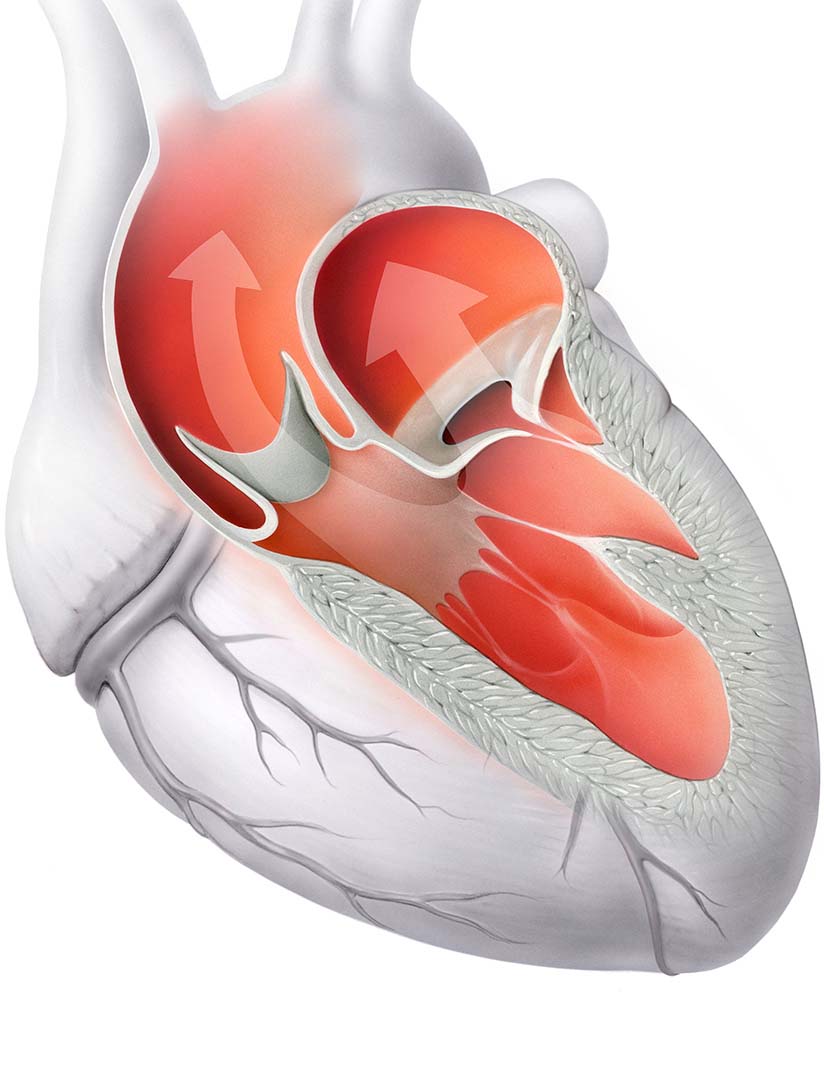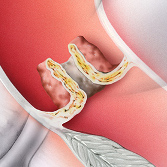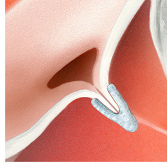Diseases of the heart valves
Diseases of the heart valves involve the reconstruction or replacement of the aortic or mitral valve. In rare cases, the tricuspid or pulmonary valves are affected. As an alternative to heart surgery, patients can be treated at HerzKlinik Hirslanden with a catheter-assisted procedure (TAVI, Mitraclip or Pascal).
In Switzerland, heart valve operations are performed as highly specialized procedures only in selected clinics. An important criterion in the selection of the medical team is the number of cases and the average mortality of the interventional or surgical procedures. The mortality rate for heart valve operations in Switzerland is approximately 4%.
Since 2013, specialists at HerzKlinik Hirslanden have performed >100 minimally invasive surgeries and more than 200 catheter-assisted valve interventions annually. In the process, the risk has been reduced to less than 1%.
Heart valve diseases
Valve function of the four heart valves
The heart valves control the flow of blood from the atria to the main chambers and from the main chambers to the large arteries by opening and closing at specific times.
The heart has four heart valves. The tricuspid valve and mitral valve are located between the atria and the main chambers. The pulmonary and aortic valves are located at the junction of the main chambers with the large blood vessels, the pulmonary artery and the aorta, respectively.
Disease of the heart valves blocks the blood flow
If one or more heart valves are diseased, they can no longer perform their valve function properly. The heart blocks the blood flow. As the disease progresses, not enough blood - oxygen and nutrients - reaches the body, which can lead to breathing difficulties and weakness.
Most valve diseases develop in adulthood, especially following certain infectious diseases or inflammation of a rheumatic nature, which may also have occurred many years before valve disease. The first signs of valve disease are usually a drop in physical performance or shortness of breath after exertion, such as when climbing stairs.
Heart failure is the main risk
If the heart valves are dilated, narrowed, no longer sealed or even torn, they no longer close and the blood flows back into the ventricles, or atria, with every heartbeat.
In valve dysfunction, the heart has to work harder to supply the body with sufficient blood - oxygen and nutrients. The extra work can lead to damage to the heart muscle in the long term. With increasing duration, the damaged heart muscle can no longer perform the necessary extra work.
Over time, the heart becomes so weakened that the overall performance of the affected person is greatly reduced. In the worst case, cardiac arrhythmia or even heart failure can occur.
Heart failure can occur because the weakened heart muscle no longer pumps the incoming blood from the heart into the body and is then collected in the pulmonary vessels.
A high pressure is formed there, which damages the pulmonary vessels and forces water into the lung tissue. Because the damage to the pulmonary vessels is irreversible, the operation should be performed before the damage is irreversible.
Drug therapies cannot cure heart valve diseases
With the help of medication, the heart affected by valve disease can be relieved. Drugs can be used to reduce the accumulation of fluid in the lungs or lower legs or to temporarily treat rhythm disturbances. However, all drug therapies do not cure heart valve disease. There are basically two surgical options for valve diseases: Reconstruction or valve replacement.
Functional disorders of the heart valves
Valve stenosis (narrowed heart valve)
The flap does not open completely. It's narrowed. Blood is pooling in front of the valve. The amount of blood pumped through the body is reduced. The heart needs to pump more.
Valve insufficiency (leaking heart valve)
The flap does not close completely, so that the blood flows backwards instead of forwards. The uncontrolled blood reflux reduces the pumping capacity of the heart. Pressure builds up on the lungs and heart.
Diseases of the aortic, mitral or tricuspid valve
Surgical or catheter-based valve intervention
There are basically two surgical options for valve diseases: The reconstruction or replacement of the heart valves. As an alternative to surgical intervention, patients with increased surgical risk will be treated with a catheter-based procedure (TAVI or Mitraclip) minimally invasive.
Deciding on the optimum procedure
The heart team and patients consult and decide together on the best procedure for heart valve diseases. The best result for our patients is our focus.
HerzKlinik Hirslanden has proven heart specialists with many years of experience in the treatment of heart valve diseases. Thanks to state-of-the-art diagnostics and the interdisciplinary heart team approach, our patients benefit from the best possible care before and after valve intervention.
Options for aortic valve diseases (stenosis and insufficiency)
Patients with aortic valve dysfunction, especially stenosis or insufficiency, can choose between surgical aortic valve surgery and the minimally invasive transcatheter aortic valve implantation procedure (TAVI).
Options for mitral valve disease (insufficiency and stenosis)
For patients suffering from mitral valve dysfunction (whether due to leakage or narrowing), mitral valve surgery and catheter-assisted mitral clipping are therapeutic options.
Options for a leaky tricuspid valve (valve insufficiency)
For patients suffering from tricuspid valve dysfunction, whether due to leakage or narrowing, valve surgery or catheter-assisted clipping are therapeutic options.




















(aortic stenosis)